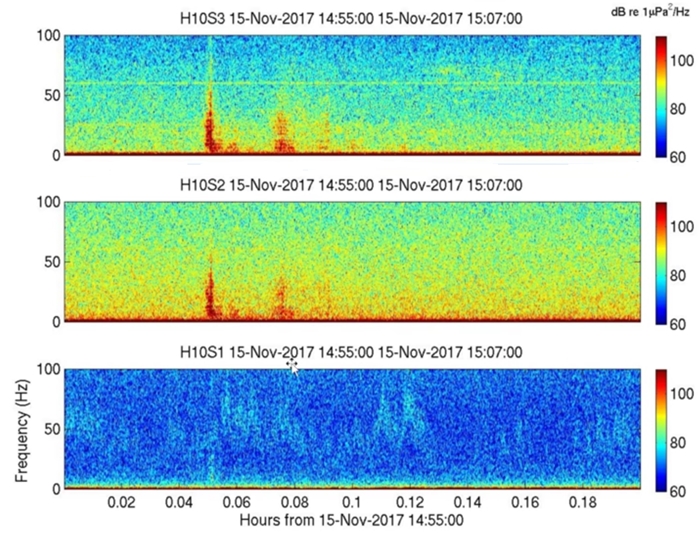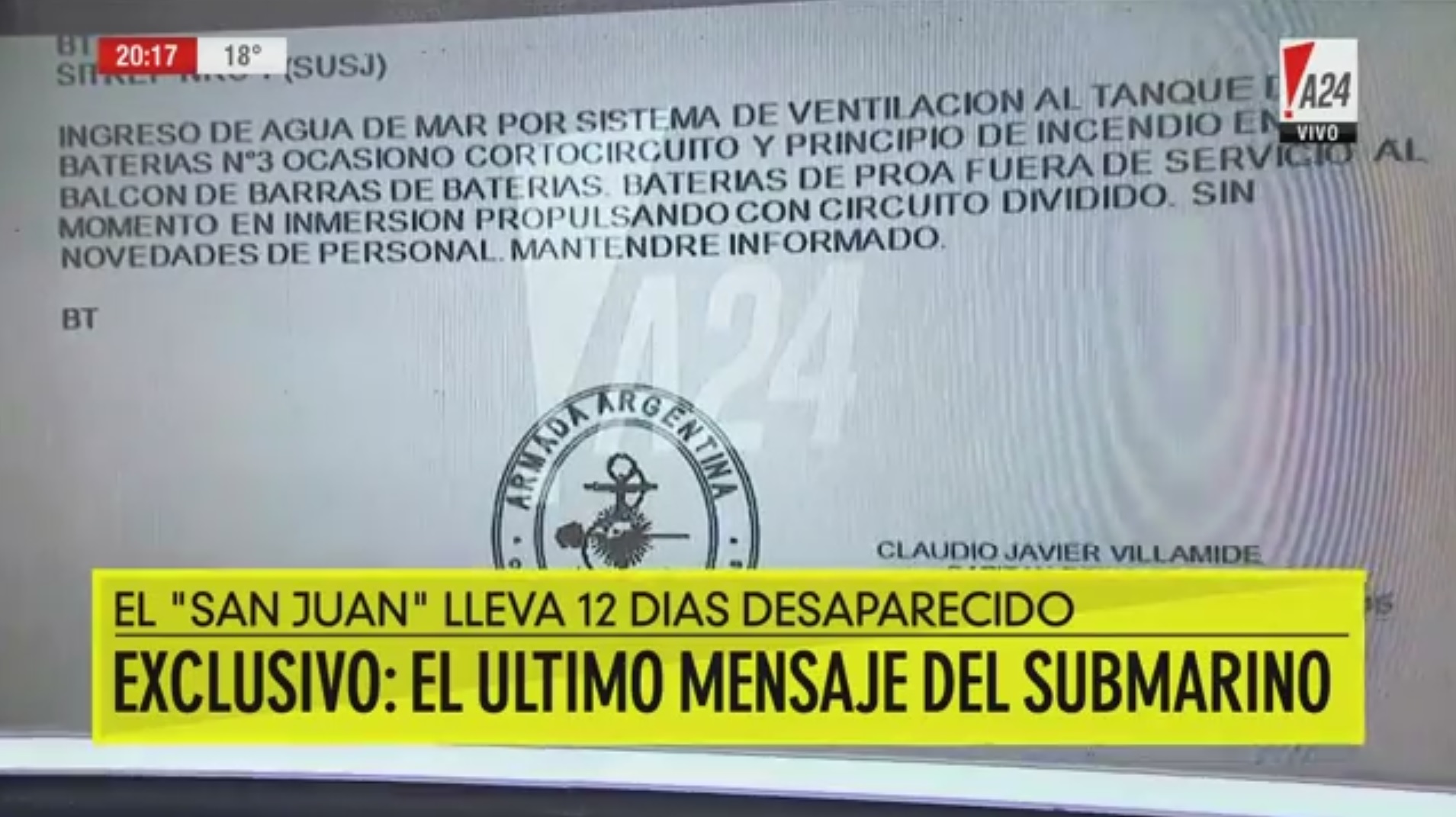Flotsam – November
Argentine submarine ARA San Juan lost in the South Atlantic Ocean
On 15 November the Argentinean Navy lost radio contact with its submarine ARA San Juan. As a result, an unprecedented international search and rescue operation was carried out, involving more than 30 ships and aircraft from 16 nations, including Germany, which initially did not reveal the fate of the submarine and its crew. In this Flotsam edition, a precise chronology of events is to be given, which put not only the relatives of the crew gathered at San Juan´s base in Mar del Plata on an emotional roller coaster ride between hopes and fears for two weeks.

6-9 November – Participation Etapa de Mar III
The ARA San Juan took part in the Argentinian Navy’s Etapa de Mar III military exercise alongside two destroyers, a corvette, a transport ship and an icebreaker as well as naval aircrafts and infantry. The highlight of this exercise, which took place in the Beagle Canal, a natural waterway in the south of Tierra del Fuego, connecting the Atlantic to the Pacific Ocean, was certainly the sinking of the ARA Comodoro Somellera by a live Exocet rocket fired by one of the participating destroyers. Built in World War II for the US Navy, the Comodoro Somellera was a decommissioned Argentinean rescue tugboat. After sinking in 1998 during a storm in the port of Ushuaia, Argentina’s southernmost city, it was raised again in order to be used as a target-ship. The exercise took place against the backdrop of renewed tensions with Britain, intensified by a British military exercise at the end of October on the Falkland Islands, which are still occupied by Argentina. Upon completion of the exercise, the San Juan marched to Ushuaia for a fleet visit with other units participating in the exercise before marching back to her home base in Mar del Plata.
Wednesday, 15 November – The final radio contact
Approximately halfway between Ushuaia and Mar del Plata, about 200 miles off the Argentinean coast, there has been a last radio contact between the San Juan and the command of the Argentine submarines on November 15th.
Thursday, 16 November – The search begins
After the San Juan had not reported by radio as ordered, the Argentinean navy started a search with two of their corvettes and an airplane.
Friday, 17 November – International aid
In order to keep abreast of the search, Argentinean President Mauricio Macri travelled to his summer residence Chapadmalal near Mar del Plata. Relatives of the San Juan crew began to gather at the naval base Mar del Plata for more information. A communication team was set up especially for these families and psychologists were called from Buenos Aires to provide them with their counselling. The Argentinean Defence Minister also went to Mar del Plata and set up his operations centre there. The International Submarine Escape and Rescue Liaison Office (ISMERLO) in Northwood/Great Britain was informed and an international rescue operation was launched. The ISMERLO was set up in 2003 against the background of the sinking of the Russian submarine Kursk and is intended to coordinate international submarine rescue operations and thus enable rapid, global intervention in the event of submarine accidents during peacetime.
Saturday, 18 November – The Iridium signals
When the Argentinean Navy announced that it had picked up seven signals from satellite telephones that may have originated from the San Juan crew, the hope of finding the submarine and its crew was raised. Between 10:52 and 15:42 hours, seven attempted satellite calls of a duration of between 4 and 36 seconds were picked up. The signals were very weak and no satellite connection could be established.
Sunday, 19 November
The Argentinean navy admitted that there was no clear evidence that the signals picked up came from the San Juan crew. Storm and waves with a height of 5-6 m hindered the rescue operation considerably, it was to be expected that the weather conditions would not improve until 21 November.
Monday, 20. November – Sounds on the seabed
If the disappearance of the San Juan had been merely a communication problem, it should have arrived in Mar del Plata on 19 or 20 November. If it had been under water since 15 November, its oxygen reserves, which lasted for a maximum of 7 days, would have slowly ran out. While the search for the missing submarine thus entered a critical phase, there was renewed hope for a brief time when the Argentinean Navy announced that several of its ships and the sonar buoys of an American P-8A Poseidon naval reconnaissance aircraft had picked up sounds that were thought to have been knocking signs of the crew trapped underwater in their submarine. When the Argentinean navy announced a short time later that these noises were probably of natural origin and could not be connected to a submarine, these hopes were shattered. International efforts to find San Juan intensified despite the persistently poor weather conditions.

Tuesday, 21. November – Further wrong tracks
The weather improved and the search was intensified. Around 7 p. m. local time, the British ice-strength patrol and research vessel HMS Protector, which was involved in the search, sighted an orange and two white flares, which ultimately could not be connected to the San Juan. Unofficial naval sources also reported a heat signature in about 70 m water depth, which was detected by an American aircraft outside the search area in the last hours of November 21. The Argentinean Navy immediately sent ships to investigate this heat signature, but did not want to confirm this officially.

Wednesday, 22 November
While the search continued unabated, the Argentinean navy received initial hints from the United States about a hydroacoustic anomaly in the area of the disappearance of the San Juan.
Thursday, 23 November – The hydroacoustic anomaly
When the Argentinean Navy officially announced that it had received information from the Organization of the Comprehensive Nuclear Test Ban Treaty Organisation (CTBTO) on a hydroacoustic anomaly, which coincided with the information from the previous day and indicated an explosion in the area where the San Juan went missing, many of the crew relatives gathered at the submarine base in Mar del Plata burst into tears. After the series of wrong tracks in the previous days, the optimism that had hitherto prevailed among the relatives disappeared.

As the disappearance of San Juan became public, CTBTO researchers also began to investigate the data from two of their hydroacoustic monitoring stations, which are closest to the sea area where the San Juan went missing, for anomalies associated with the disappearance of the submarine. The CTBTO has a total of 11 hydroacoustic monitoring stations worldwide, which monitor the oceans with special sensors for low-frequency sound waves. They are one of the four measuring networks of the international monitoring system IMS, which also has networks of stations for seismic and barometric monitoring as well as for the detection of radionuclides. All data are collected at the International Data Centre (IDC) in Vienna, where they are stored, evaluated and made available to the 183 member states.
The two hydroacoustic monitoring stations involved are located on Ascension, which is located in the South Atlantic between Africa and South America, and on the Iles Crozet in the southern Indian Ocean between Madagascar and the Antarctic. Basically, their software is designed for the detection of nuclear explosions, so that the researchers were looking for a comparatively small sound event, which could be caused by a conventional submarine like the San Juan. They had to search through enormous amounts of data manually or with the help of specially quickly programmed software. Thus it is to be explained that the CTBTO did not announce until 23 November that it had already picked up an unusual signal in the area of the disappearance of the San Juan on 15 November. It was a abnormal, singular, short, violent, non-nuclear broadband signal that had no resemblance whatsoever to underwater sounds of natural origin, such as earthquakes or the like, but had some characteristics of an explosion.

Friday, 24 November
More than 30 ships and airplanes and more than 4,000 people from 13 nations searched for the San Juan. The search area was expanded to about 500,000 km², which is approximately the size of Spain. Germany was represented in the search with one of its P-3 Orion naval reconnaissance aircraft.
Saturday, 25 November
After an 11-day search, there was still hope of finding the San Juan and saving her crew. In the port of Comodoro Rivadavia, the Norwegian special ship Sophie Siem was feverishly modified to accommodate an American submersible for depths of up to 600 metres.
Sunday, November 26th
In the afternoon, the Sophie Siem was able to sail and take part in the search for the missing submarine with the submersible.
Monday, 27 November – The last radio message from the San Juan

The Argentinean Navy released the last message of the San Juan. This states that water ingress through the battery ventilation system has caused a short circuit in the forward batteries which has caused a fire on their connector bars. The front batteries are therefore out of service, so that the submarine could only continue with the aft batteries. Crew members were not harmed.
Tuesday, 28 November
The spokesman of the Argentinean Navy pointed out that all parties involved would experience “critical and stressful hours” at this time. The Argentine Federal Judge Marta Yañez, responsible for the San Juan case, requested the government to lift the military secret in order to access information on the case from the Navy.
Thursday, 30 November – All hope is lost
The Argentinean Navy gave up all hope of finding the crew of the San Juan alive and officially ended the rescue operation. In the meantime, the search for the wreck of the San Juan continued.
Weblink:
